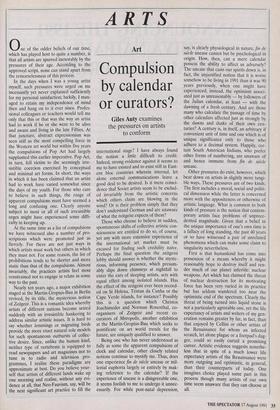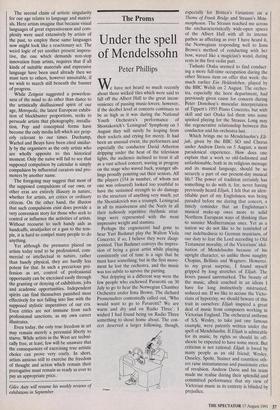ARTS
Art
Compulsion by calendar or curators?
Giles Auty examines the pressures on artists to conform One of the odder beliefs of our time, which has played host to quite a number, is that all artists are spurred inexorably by the pressures of their age. According to the approved script, none can stand apart from the remorselessness of this process.
In the days when I was a young artist myself, such pressures were urged on me incessantly yet never explained sufficiently for my personal satisfaction; luckily, I man- aged to retain my independence of mind then and hang on to it ever since. Profes- sional colleagues or teachers would tell me only that this or that was the way an artist had to work if he or she were to be alive and aware and living in the late Fifties. At that juncture, abstract expressionism was seen still as the most compelling force in the Western art world but within five years the compulsions of Pop Art had largely supplanted this earlier imperative. Pop Art, in turn, fell victim to the seemingly irre- sistible coercion exercised by conceptual and minimal art forms. In short, the ways in which it has been claimed that an artist had to work have varied somewhat since the days of my youth: For those who care to believe in such things, the range of apparent compulsions must have seemed a long and confusing one. Clearly anyone subject to most or all of such irresistible urges might have experienced some diffi- culty in keeping up.
At the same time as a list of compulsions we have witnessed also a number of pro- scriptions which were promoted just as fiercely. For there are not just ways in which artists must work but others in which they must not. For some reason, the list of prohibitions tends to be shorter and more static than that of the compulsions. Almost invariably, the practices artists feel most - constrained not to engage in relate in some way to the past.
Nearly ten years ago, a major exhibition staged at the Martin-Gropius-Bau in Berlin revived, by its title, the mysterious notion of Zeitgeist. This is a romantic idea whereby artists of different nations become seized suddenly with an irresistible hankering to address similar artistic issues. It is hard to say whether lemmings or migrating birds provide the more exact natural role models for such spontaneous outbursts of collec- tive desire. Since, unlike the human kind, neither type of vertebrate is equipped to read newspapers and art magazines nor to tune in to radio and television pro- grammes, I realise these paradigms are approximate at best. Do you believe your- self that artists of different lands wake up one morning and realise, without any evi- dence at all, that Neo-Fauvism, say, will be the next significant art practice to fill the
international stage? I have always found the notion a little difficult to credit. Indeed, strong evidence against it seems to me to have existed and to exist still in East- ern bloc countries wherein internal, let alone external communications leave a good deal to be desired. Is it mere coinci- dence that Soviet artists seem to be exclud- ed invariably from the artistic concerns which others claim are blowing in the wind? Or is their problem simply that they don't understand German and are unaware of what the zeitgeist expects of them?
Those who choose to believe in sudden, spontaneous shifts of collective artistic con- sciousness are entitled to do so, of course, yet any with more extensive experience of the international art market must be excused for finding such credulity naïve. Perhaps the final question the zeitgeist lobby should answer is whether the myste- rious, informing presence, which presum- ably slips down chimneys at nightfall to enter the ears of sleeping artists, acts with equal effect among isolated islands. Has the effect of the zeitgeist ever been record- ed on St Helena, Tristan da Cunha or the Cape Verde islands, for instance? Possibly this is a question which Christos Joachimedes and Norman Rosenthal, co- organisers of Zeitgeist and recent co- curators of Metropolis, another exhibition at the Martin-Gropius-Bau which seeks to pontificate on art world trends for the future, are uniquely qualified to answer.
Being one who has never understood as fully as some the apparent compulsions of clock and calendar, other closely related notions continue to mystify me. Thus, does one experience fin de siècle unease or mil- lenial euphoria largely or entirely by mak- ing reference to the calendar? If the experience of unease is a disagreeable one, it seems foolish to me to undergo it unnec- essarily. For while post-natal depression, say, is clearly physiological in nature, fin de siècle unease cannot but be psychological in origin. How, then, can a mere calendar possess the ability to affect us adversely? The unease that casts our spirits down is, in fact, the unjustified notion that it is worse somehow to be living in 1991 than it was 90 years previously, when one might have experienced, instead, the optimism associ- ated just as unreasonably — by followers of the Julian calendar, at least — with the dawning of a fresh century. And are those many who calculate the passage of time by other calendars affected just as strongly by the dawns and dusks of their own cen- turies? A century is, in itself, an arbitrary if convenient unit of time and one which is of unique significance only to those who adhere to a decimal system. Happily, cer- tain South American Indians, who prefer other forms of numbering, are unaware of and hence immune from fin de siecle unease.
Other pressures do exist, however, which bear down on artists in slightly more tangi- ble ways. These pressures are of two kinds. The first includes a moral, social and politi- cal dimension while the latter is concerned more with the appositeness or otherwise of artistic language. What is common to both kinds of pressure is the notion that contem- porary artists face problems of unprece- dented magnitude. Given that a belief in the unique importance of one's own time is a fallacy of long standing, the past 40 years or so have witnessed a pair of unrelated phenomena which can make some claim to singularity nevertheless.
First is that humankind has come into possession of a means whereby it might reasonably hope to destroy itself and ren- der much of our planet infertile: nuclear weapons. Art which has claimed the threat of nuclear destruction for its motivating force has been very varied in its practice but has seldom wandered too near the optimistic end of the spectrum. Clearly the threat of being turned into liquid stone is not a particularly agreeable one, yet the life expectancy of artists and writers of my gen- eration remains greater by far, in fact, than that enjoyed by CeRini or other artists of the Renaissance for whom an infected scratch, let alone plague or a footpad's dag- ger, could so easily curtail a promising career. Artistic evidence suggests nonethe- less that in spite of a much lower life expectancy artists of the Renaissance were more outgoing and optimistic, in general, than their counterparts of today. One imagines choice played some part in this process though many artists of our own time seem unaware that they can choose at all. The second claim of artistic singularity for our age relates to language and materi- als. Here artists imagine that because visual languages of great expressiveness and com- plexity were used extensively by artists of the past, to employ these same languages now might look like a reactionary act. The weird logic of yet another present impera- tive, the one which demands non-stop innovation from artists, requires that if all kinds of suitable materials and expressive language have been used already then we must turn to others, however unsuitable, if we wish to march still beneath the banner of progress.
While Zeitgeist suggested a powerless- ness of the mind to do other than dance to the artistically disillusioned spirit of our age, Metropolis, the latest European exhibi- tion of blockbuster proportions, seeks to persuade artists that photography, installa- tion, Pop and conceptual forms have become the only media left which are prop- erly relevant to our times. Duchamp, Warhol and Beuys have been cited similar- ly by the organisers as the only artists who are wholly apposite to this historical moment. Only the naive will fail to see that supposed compulsion by calendar is simply compulsion by influential curators and pro- moters by another name.
The foregoing may suggest that most of the supposed compulsions of our own, or other eras are entirely illusory in nature, whether for artists, art critics or ordinary citizens. On the other hand, the illusion that such compulsions exist does provide a very convenient story for those who seek to control or influence the activities of artists. Without recourse to such handy aids as handcuffs, straitjacket or a gun to the tem- ple, it is hard to compel many people to do anything. Yet although the pressures placed on artists today tend to be professional, com- mercial or intellectual in nature, rather than basely physical, they are hardly less potent for that. In such a precarious pro- fession as art, control of professional Opportunity can be exercised easily through the granting or denying of exhibitions, jobs and academic opportunities. Independent spirits can find themselves punished most effectively for not falling into line with the supposed stylistic imperatives of our era. Even critics are not immune from such professional sanctions, as my own career illustrates.
Even today, the only true freedom in art may remain merely a perennial liberty to starve. While artists in the West are techni- cally free, at least, few will be unaware that the consequences of exercising true artistic choice can prove very costly. In short, artists anxious still to exercise the freedom of thought and action which remain their prerogative must remain as ready as ever to pay an appropriate price.
Giles Auty will resume his weekly reviews of exhibitions in September.



















































 Previous page
Previous page